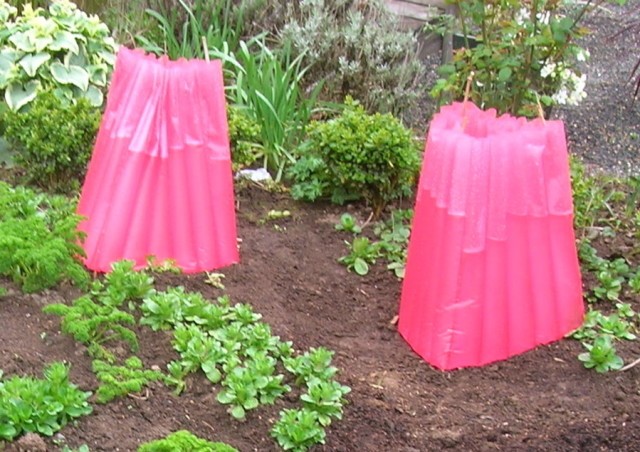Question: When is the Best Time to Plant Tomatoes and Summer Flowers?

Setting these up a couple of weeks before you set your tomatoes outdoors helps warm the soil… and once you tuck your little tomato plants inside them, they keep the air warmer around the plants at night, too.
Here’s the burning question on most Portland area gardeners’ minds right now: CAN I PLANT MY TOMATOES OUT IN MY GARDEN YET?
The answer is, yes – yes you can – but you shouldn’t quite yet, unless you enjoy watching plants sit pitifully in the cold earth doing absolutely nothing. Instead, wait a couple of weeks longer, until nighttime air temperatures are consistently over 50F. Even though warm-weather vegetables and flowers are showing up on nursery benches locally, just avert your eyes and walk on by – unless you want to nurse them along in pots on your warm windowsill or – if you’re lucky – a greenhouse.
Instead, just pull out your handy-dandy soil thermometer (about $10 at local nurseries) and check that the garden soil where you’re planting tomatoes is 60F or higher Around here, that’s a better indicator that the time is nigh to plant tomatoes than whether they’re on the shelves at Fred Meyers.
If your tomato plot is unusually warm – say, beneath a south wall or with lots of concrete around it – it’s possible you could have a microclimate that’s ready for tomatoes. That’s why a soil thermometer is such a good idea!
Here’s what you can do now, though: buy some Walls-O-Water or Kozy Coats and set them up. These products serve as little tents for planting tomatoes, peppers or eggplants. Fill the channels with water from the hose and you’ll warm up the soil underneath your tender summer plants – and, once you plant, these tents will keep the plants warmer, especially at night, during those first few critical weeks in the ground. Note: I always dig and loosen the soil before setting up my Wall-O-Water so that it’s easy to reach inside the tent and plant. Trying to move a Wall-O-Water, filled with water, is not my idea of fun. Just wear galoshes if you find you have to do it.
More Tomato Tips:
Use a soil thermometer to test the temperature of the soil in your vegetable garden. For tomatoes to survive, soil temperatures should be a minimum of 50-55 F for the most cold-hardy types like ‘Oregon Spring’. For tomatoes to thrive, soil temperatures should be well into the 60s. Soil temperatures over 70 really spark growth. Optimum air temps are 75 to 95 F; air temperatures below 57F delay growth and encourage tomato disease. All this to say: waiting just a week or three longer can mean your plants could surpass those planted too early.
Try Kozy Coats or Wall-’O-Water products or use red or black plastic sheets to warm the soil. This will help raise the soil temperature by a few meaningful degrees. The Kozy Coats and Wall-O-Waters also keep the air around the plants warmer – especially important when night temps are low.
When purchasing tomatoes, choose a stocky, stout, leafy specimen over a tall, thin one. If you have to plant a scrawny one, bury the first set or two of leaves in the ground – it will root along the stem and strengthen the plant.
Rotate the position of your tomatoes in the garden so that you aren’t planting them where they – or their close relatives (pepper, eggplant, and potato) – have been planted in recent years. This helps discourage soil-borne disease.
When planting, give your tomato plants room. Space typical staked tomatoes an absolute minimum of two feet apart to allow for air circulation and better light and to discourage disease. Three feet is a lot better, especially for huge "indeterminate": tomato plants.
Plant your tomato up to the first set up leaves if they are straggly at all. The plants will root along the stem, helping to support strong, healthy growth, as well as deepening the root system – useful in our dry summer climate.
Pinching side shoots is a matter of preference. It hasn’t been shown to make a difference in productivity either way, although it can neaten a plant. And side shoots can produce fruit and flowers. Interestingly… you can speed fruit production in indeterminate tomatoes by pinching the terminal growth (top) towards the season’s end.
Water consistently – deeply and every few days. If the plants go dry in mid-summer, don’t go crazy compensating if the plant is loaded with fruit – this can lead to fruit cracking. Instead, provide steady, regular moisture every few days, as the weather dictates.
Mulch the plants with mulch, straw, or shredded leaves after the soil has warmed up in early July. Mulch helps with splash-back from the soil, which could carry disease, especially if tomatoes have been grown there in the past. It also helps retain soil moisture during the dry summer months.
